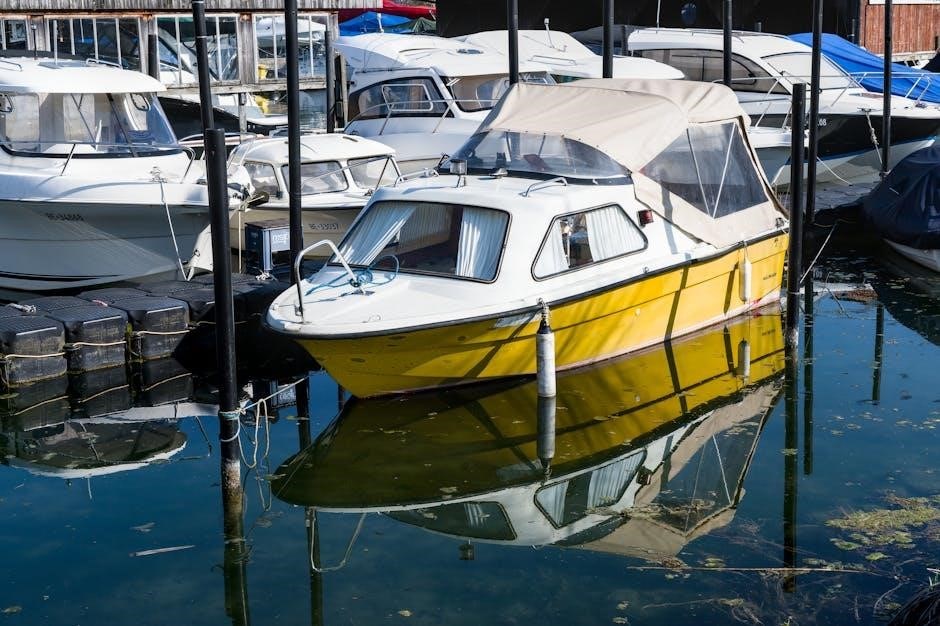Inlet Guide Vanes (IGVs) are crucial components in turbines and compressors, designed to optimize airflow for improved performance, efficiency, and reliability in aerospace and industrial applications.
1.1 Definition and Basic Function
Inlet Guide Vanes (IGVs) are aerodynamic devices installed upstream of compressors or turbines to regulate and direct airflow efficiently. Their primary function is to optimize the angle and distribution of incoming air, ensuring smoother compression and reducing energy losses. By aligning airflow with compressor blades, IGVs enhance performance, stability, and fuel efficiency, particularly during part-load operations in gas turbines and industrial applications.
1.2 Historical Background and Evolution
Inlet Guide Vanes (IGVs) emerged in the mid-20th century as a response to the need for improved compressor efficiency in early jet engines. Initially simple fixed vanes, they evolved into variable designs to adapt to changing operating conditions. Advances in materials and aerodynamic modeling led to modern IGVs, which now incorporate smart technologies and optimized geometries, significantly enhancing performance, reducing emissions, and improving reliability across aerospace and industrial applications.

Design and Types of Inlet Guide Vanes
Inlet Guide Vanes are designed in fixed or variable configurations, engineered to optimize airflow and compression efficiency through precise aerodynamic shaping and strategic placement.
2.1 Fixed vs. Variable Inlet Guide Vanes
Fixed IGVs are stationary components designed for specific operating conditions, optimizing performance under steady-state flows. Variable IGVs, however, adjust their angle to regulate airflow, enhancing efficiency across diverse operating ranges. While fixed vanes offer mechanical simplicity, variable designs provide flexibility, enabling better compression efficiency and turbine performance at part loads, though they introduce complexity in design and maintenance.
2.2 Aerodynamic Design Considerations
Aerodynamic design of IGVs focuses on optimizing airflow regulation and minimizing energy losses. Key factors include vane angle, shape, and material selection to ensure efficient airflow distribution. Advanced manufacturing techniques enable precise geometries, reducing turbulence and enhancing compression efficiency. Proper design ensures smooth airflow transition, critical for maintaining turbine and compressor performance across varying operating conditions.

Operating Principles of IGVs
IGVs regulate airflow by adjusting vane angles, ensuring optimal compression efficiency and turbine performance across various operating conditions.
3.1 Airflow Regulation and Compression Efficiency
Inlet Guide Vanes (IGVs) regulate airflow by adjusting vane angles, optimizing the air’s direction and velocity as it enters compressors or turbines. This precise control enhances compression efficiency by minimizing energy losses and ensuring uniform airflow distribution. Proper IGV adjustment reduces turbulence and optimizes pressure ratios, leading to improved overall system performance and reliability across various operating conditions.
3.2 Role in Turbine and Compressor Systems
In turbine and compressor systems, IGVs play a vital role by directing and conditioning incoming air to achieve optimal performance. They stabilize airflow, reduce turbulence, and ensure efficient compression. By precisely controlling air velocity and direction, IGVs enhance turbine and compressor efficiency, reliability, and overall system output, making them indispensable in both aviation and industrial applications.

Performance Optimization with IGVs
IGVs optimize system performance by enhancing airflow control and compression efficiency, reducing fuel consumption and emissions, especially at part loads, improving overall operational effectiveness.
4.1 Enhancing Turbine Efficiency at Part Loads
IGVs play a pivotal role in enhancing turbine efficiency during part-load operations by regulating airflow and optimizing compression. By adjusting the vane angles, IGVs ensure consistent airflow distribution, reducing energy losses and improving stability. This leads to better fuel efficiency, lower emissions, and increased operational reliability. Variable IGVs adapt to changing load conditions, maintaining peak performance and minimizing performance degradation, making them essential for modern turbine systems.
4;2 Impact on Fuel Consumption and Emissions
IGVs significantly reduce fuel consumption by optimizing airflow, leading to improved combustion efficiency. This reduction in fuel use directly lowers greenhouse gas emissions, contributing to environmental sustainability. Additionally, by minimizing energy losses and enhancing turbine performance, IGVs help meet stringent emission regulations while cutting operational costs, making them a critical component in eco-friendly and cost-effective turbine systems.

Applications of Inlet Guide Vanes
Inlet Guide Vanes are widely used in aerospace for jet engine efficiency and in industrial turbines for power generation, enhancing performance across various applications.
5.1 Aerospace and Aviation Engines
In aerospace, IGVs play a critical role in optimizing jet engine performance. They regulate airflow into compressors, ensuring efficient operation across varying altitudes and speeds. This enhances fuel efficiency and reduces emissions, making them essential for modern aviation engines. Their precise control over air intake is vital for maintaining stable combustion and meeting stringent emissions standards in the aviation industry.
5.2 Power Generation and Industrial Turbines
In power generation, IGVs are essential for optimizing industrial turbine performance. They regulate airflow to enhance efficiency, reduce emissions, and ensure stable operation under varying loads. IGVs are critical in gas turbines used for electricity generation, enabling better combustion control and fuel flexibility. Their role in industrial applications is vital for maintaining reliability and minimizing environmental impact in large-scale power production systems.

Maintenance and Troubleshooting
Regular inspections and cleaning of IGVs are essential to prevent debris buildup and performance degradation. Proper alignment ensures optimal airflow and efficiency in turbine operations.
6.1 Common Issues and Failures
Common issues with IGVs include fouling from debris, erosion due to abrasive particles, and mechanical damage from improper handling. Misalignment or wear can disrupt airflow, reducing efficiency and causing turbine instability. Regular inspections are critical to identify and address these problems early, ensuring optimal performance and preventing costly repairs or downtime in industrial and aerospace applications.
6.2 Best Practices for Inspection and Repair
Regular inspection of IGVs involves checking for wear, fouling, and alignment issues. Use advanced imaging tools for detailed analysis. During repairs, ensure precise realignment and replace damaged components promptly. Apply protective coatings to prevent erosion and corrosion. Follow manufacturer guidelines for cleaning and maintenance to restore optimal performance and extend service life in both aerospace and industrial turbine systems. This ensures reliability and efficiency.

Advancements in IGV Technology
Modern materials and smart control systems enhance IGV performance, enabling real-time optimization and improved efficiency through advanced manufacturing and integration with IoT for predictive maintenance.
7.1 Modern Materials and Manufacturing Techniques
Advancements in materials like titanium alloys and ceramic composites have improved IGV durability and resistance to high-temperature stress. Modern manufacturing techniques, such as 3D printing and CNC machining, enable precise geometries and reduced production times. These innovations enhance performance while minimizing material waste, contributing to cost-effective and sustainable solutions for industrial and aerospace applications.
7.2 Integration with Smart Control Systems
The integration of IGVs with smart control systems enables real-time monitoring and dynamic adjustments, optimizing performance. Predictive maintenance and IoT connectivity reduce downtime and enhance efficiency. Advanced algorithms analyze operational data to anticipate wear and tear, ensuring proactive adjustments. This seamless integration improves responsiveness, reduces emissions, and lowers operational costs, making IGV systems more adaptable to varying conditions and industry demands.

Environmental Impact and Sustainability
Inlet Guide Vanes enhance turbine efficiency, reducing fuel consumption and emissions, thus lowering the carbon footprint and aiding compliance with environmental regulations.
8.1 Reducing Carbon Footprint
Inlet Guide Vanes (IGVs) play a crucial role in minimizing environmental impact by optimizing airflow, which enhances turbine and compressor efficiency. This optimization leads to reduced fuel consumption and lower greenhouse gas emissions, directly contributing to a smaller carbon footprint. Improved efficiency also results in cost savings and aligns with global sustainability goals, making IGVs a key component in eco-friendly industrial and aerospace applications.
8.2 Compliance with Emission Regulations
Inlet Guide Vanes (IGVs) contribute significantly to meeting stringent emission standards by optimizing turbine and compressor performance. By improving airflow regulation, IGVs reduce harmful emissions, ensuring compliance with global environmental regulations such as Euro 6 and EPA standards. Their ability to enhance efficiency directly supports efforts to minimize environmental impact while adhering to legal requirements, making them a vital component in eco-compliant industrial and aerospace systems.

Case Studies and Real-World Applications
Inlet Guide Vanes have proven their effectiveness in real-world scenarios, enhancing turbine performance in aerospace and industrial applications, with notable success in improving efficiency and reducing operational costs.
9.1 Successful Implementation in Gas Turbines
In gas turbines, Inlet Guide Vanes (IGVs) have been successfully implemented to optimize compressor performance by regulating airflow and enhancing compression efficiency. Their ability to adjust guide vane angles ensures improved turbine performance across various operating conditions. Real-world applications demonstrate significant reductions in fuel consumption and emissions, with case studies showing up to a 12% improvement in turbine efficiency, making IGVs a critical component in modern gas turbine systems.
9.2 Lessons Learned from Industrial Use
Industrial use of IGVs has highlighted their effectiveness in optimizing turbine performance, especially under varying loads. However, challenges such as fouling and wear require regular maintenance. Proper inspection and repair protocols are essential to sustain efficiency. Economic benefits include reduced fuel consumption and lower emissions, enhancing overall cost-effectiveness. Material advancements have improved durability, reducing downtime and costs.
Future Trends and Innovations
Future trends in IGV technology include next-generation designs with adaptive geometries and smart materials, enhancing efficiency and operability. Innovations in 3D printing and AI-driven optimization are expected to revolutionize their performance and integration in advanced systems.
10.1 Predictive Maintenance and IoT Integration
Predictive maintenance and IoT integration are revolutionizing IGV management by enabling real-time monitoring and data-driven decision-making. Sensors embedded in IGVs collect performance data, allowing for early detection of potential issues. This reduces unplanned downtime and extends equipment lifespan. Advanced analytics predict maintenance needs, optimizing schedules and resource allocation. IoT connectivity ensures seamless communication between IGV systems and control centers, enhancing operational efficiency and reliability across industries.
10.2 Next-Generation IGV Designs
Next-generation IGV designs leverage advanced materials and 3D printing for enhanced durability and aerodynamic efficiency. These designs incorporate smart technologies, such as self-adjusting vanes, to optimize performance across varying conditions. Improved geometries reduce wear and tear, while coatings and surface treatments enhance resistance to extreme temperatures and corrosion. These innovations ensure IGVs meet the demands of modern high-performance engines and industrial systems, driving efficiency and sustainability.

Challenges and Limitations
IGVs face challenges like mechanical complexity, sensitivity to extreme temperatures, and high maintenance costs. Their performance can be limited by clogging, wear, and material durability in harsh environments.
11.1 Technical Constraints and Trade-offs
IGVs face technical constraints such as mechanical complexity, sensitivity to extreme temperatures, and potential clogging from debris. Design trade-offs often balance efficiency gains against increased wear, reduced reliability, and higher maintenance needs. Variable IGV systems, while offering performance benefits, introduce added complexity in actuation and control systems, potentially leading to reliability issues if not properly maintained or designed.
11.2 Economic and Operational Challenges
IGVs present economic challenges, including high initial costs for variable designs and maintenance expenses. Operational challenges involve balancing performance needs across varying load conditions, potential wear from harsh environments, and the need for regular inspections. Despite fuel efficiency gains, the complexity and cost of IGV systems can strain operational budgets, requiring careful optimization to justify investments.
Inlet Guide Vanes play a pivotal role in enhancing turbine and compressor efficiency, offering significant performance improvements. Their continued evolution promises further advancements in energy optimization and operational reliability.
12.1 Summary of Key Points
Inlet Guide Vanes (IGVs) are essential for optimizing airflow and compression efficiency in turbines and compressors. They enhance performance at part loads, reduce fuel consumption, and lower emissions. Variable IGVs provide flexibility in different operating conditions. Their application spans aerospace, power generation, and industrial systems. By improving efficiency and reliability, IGVs play a critical role in modern energy and propulsion technologies.
12.2 Outlook for the Future of IGV Technology
The future of Inlet Guide Vanes (IGVs) lies in advanced materials, predictive maintenance, and smart control systems. Integration with IoT and real-time monitoring will enhance efficiency and reduce downtime. Next-generation designs will focus on sustainability, reducing emissions further. These innovations will drive progress in aerospace and energy sectors, ensuring IGVs remain a cornerstone of modern turbine and compressor systems.
